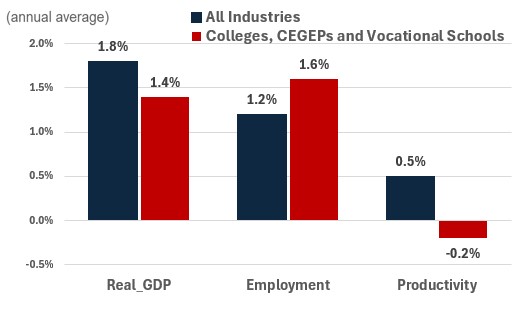Canadian Occupational Projection System (COPS)
Industrial Summary
Colleges, CEGEPs and Vocational Schools
(NAICS 6112, 6114-6117)
Community colleges and CEGEPs comprise establishments primarily engaged in providing academic or technical courses and granting associate degrees, certificates or diplomas that are below the university level. The requirement for admission to an associate or equivalent degree program is at least a high school diploma or equivalent general academic training. Vocational schools comprise establishments such as business, computer and management training schools, technical and trade schools, and other schools primarily engaged in providing instruction in fine arts, sports, languages and a variety of other topics (first-aid training, driving lessons, adult literacy programs). These establishments may be privately owned and operated, either for profit or not, or they may be publicly owned and operated. Community colleges and CEGEPs account for the largest share of output (59% in 2023), while vocational schools account for the largest share of employment (60% in 2023; with “other schools” alone accounting for 52%). This situation can be explained by the fact that vocational schools are characterized by a high proportion of part-time workers (51%) and self-employed (46%). Overall, the industry employed around 310,400 workers in 2023, with women accounting for 61% of the workforce. Employment is distributed proportionately to population: 37% in Ontario, 24% in Quebec, 18% in British Columbia, 11% in Alberta, and 11% in the remaining provinces.
Given the wide variety of activities, key occupations (5-digit NOC) include a mix of:
- College and other vocational instructors (41210)
- Other instructors (43109)
- Program leaders and instructors in recreation, sport and fitness (54100)
- Musicians and singers (51122)
- Education policy researchers, consultants and program officers (41405)
- Dancers (53120)
- Coaches (53201)
- Educational counsellors (41320)
- Post-secondary teaching and research assistants (41201)
- Administrators in post-secondary education and vocational training (40020)
Projections over the 2024-2033 period
Real GDP is projected to grow at an average annual rate of 1.4%. In the short term, real GDP is expected to decline, resulting primarily from the cap on new international student permits. Given that number of international enrolments has been on the rise, while the number of Canadian enrolments has declined in recent years, this cap on international student permits is predicted to impact sector performance. In the longer term, Canada is expected to see the growth in the number of 15- to 25-year-olds slow, putting further downward pressure on Canadian enrolments. However, over the medium term, the number of foreign students expected to come to Canada for a college education is expected to resume growth, helping drive the sector in the medium-to-long-term. In addition, the demand for a skilled workforce is expected to continue in the future, which should further drive gains in real GDP as more high school graduates enroll in post-secondary education and workers see the need to upskill. Canada’s vocational schools are also poised to benefit from the need to train workers with the skills required to meet the green transition goals.
Productivity is expected to decline at an average annual rate of 0.2%. Despite incorporating technology to provide a more flexible learning environmental, the college, CEGEP and vocational school industry is expected to remain labour intensive. While offering online courses provides greater flexibility to students, teachers will always be required to teach and grade coursework and exams, leaving little room for productivity growth in the sector. In addition, with many vocational studies required to take place in person, productivity gains are limited even further in that subsector.
Employment is projected to increase by 1.6% annually. Due to the labour intensity needs, employment growth is expected to grow at a similar pace to real GDP in order to accommodate the increased number of students associated with output growth. In addition, the large share of part-time workers in vocational schools increases the number of individual employees required to meet the equivalent full-time employment levels.
Challenges and Opportunities
Funding from provincial governments is the largest source of revenue for colleges. Changes in provincial governments could pose a risk to growth in the sector as some governments have traditionally invested more in enhancing post-secondary education than others. In addition, there is always the risk that the government prolongs or further limits the current international study permit cap. Finally, tuition plays an important role in the demand for a college, CEGEP, or vocational education. If governments choose to limit funding, institutions may need to raise tuitions in order to cover costs, which could result in sector revenues falling if enrolments decrease in response to higher prices.
Real GDP , Employment and Productivity Growth rate (2024-2033)

Sources: ESDC 2024 COPS projections.
| Real GDP | Employment | Productivity | |
|---|---|---|---|
| All Industries | 1.8 | 1.2 | 0.5 |
| Colleges, CEGEPs and Vocational Schools | 1.4 | 1.6 | -0.2 |